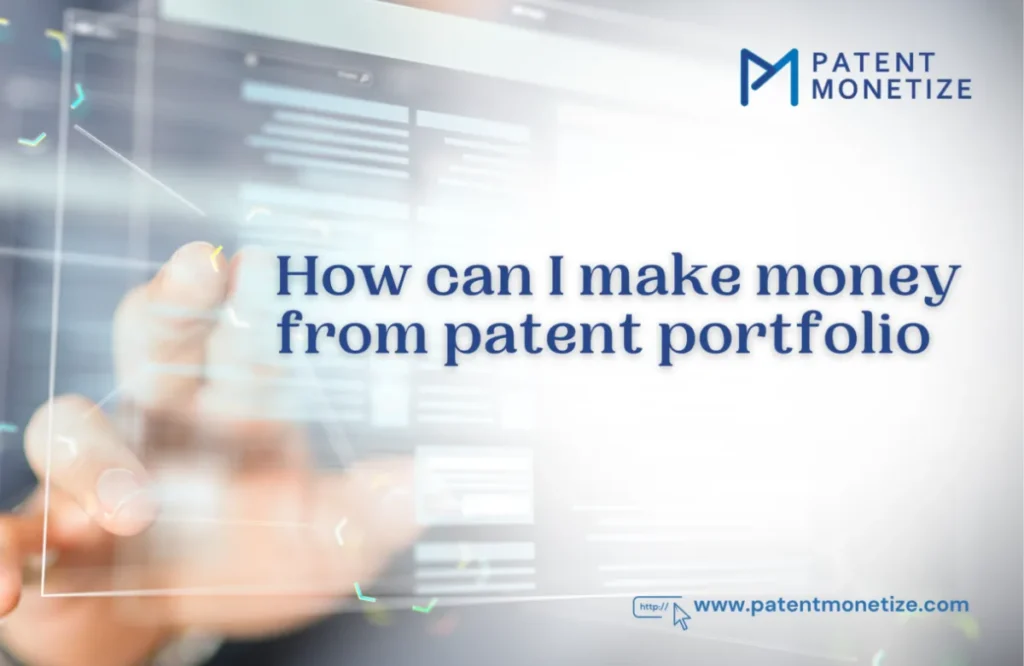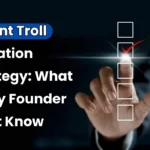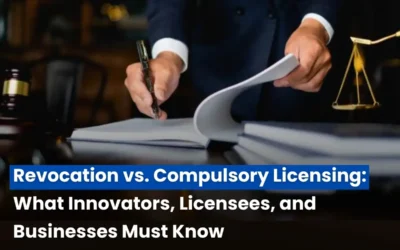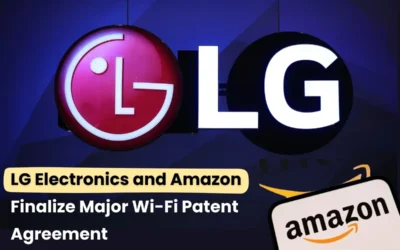
How can I make money from patent portfolio, Patents is the most precious IP, which not only safeguards innovation but can also generate revenues from it. However, it is also more frequently raising this question from all patent owners: “How to monetize my portfolio of patents?” This paper is a review of the diverse strategies and practices that exist regarding the monetization of patents in terms of its portfolio management, licensing, selling, partnerships, litigation, etc. Maximizing the financial value of the patent portfolio will help sustain success whether you are an inventor, entrepreneur, or large corporation. Understanding everything from what a patent portfolio is to how to identify and apply strategies to revenue generation is accomplished here.
1.Understanding Patent Portfolios
A patent portfolio is the accumulation of patents owned by an individual or a firm. Patents are a type of intellectual property owned by companies, and these patents can be multifaceted: there could be various technologies, several lines of products, and innovation. Companies and individuals create a patent portfolio in an effort to prevent ideas from being stolen, stop competition, and ultimately add value. Any of the enterprises can see a well-managed patent portfolio as the most valuable asset the world has in its store. All technology firms, as well as the pharmaceuticals of any size-no matter how tiny are the start-ups-may earn more than they ever dreamt working on these portfolios of patents. A patent portfolio usually refers to the granted patent together with a few underwritten applications that eventually make their way toward becoming a very well-established asset. Understanding the elements of a patent portfolio and where it may fit in your business strategy is the first step to knowing how best to monetize it.
2.Why Patent Portfolios Are Valuable
Patents are exclusive rights granted to the owners, and they can be used in several ways. The value of a patent portfolio lies in its ability to protect innovations, generate income, and strengthen market positioning. Here’s why patent portfolios are so precious for business entities:
- Exclusivity and Protection: A patent gives the exclusive rights of an invention to an inventor. Without any explicit permission, no other person can make, use, or even sell the patented invention. Therefore, it can be used for competitive advantage purposes.
- Market Leadership: A patent portfolio is successful in creating market leadership and helping to be on the top. Those who have patents are said to be in the leadership position. Their patents then come out as the requirement for any those wanting to join that market.
- Â Monetary Potential: The portfolio of patents created has immense revenue-generating capability. Though licenses and sales can provide revenue, the portfolio will even allow the company to make revenue for a long time by means of strategic relationships.
- Â Attracting Investment: Investors would definitely consider it an asset and will view a robust patent portfolio as a company that is capable of doing innovations. It would obviously make the company more attractive since it would protect from probable competition.
- Strategic Defense: Besides the monetary value, patents also have a defensive value. Companies can use their portfolios to deter a potential competitor or deter a patent infringement litigation. Companies can also use their portfolio for cross-licensing agreements.
3.Critical Methods of Making Money Out of Your Patent Portfolio
Having established the value of a patent portfolio, we’ll then go on to observe the most common ways to monetize your patents. With your patent portfolio, you unlock revenue opportunities of such significant magnitude, expand your market presence, and shore up the financial stability of your business.
Licensing
Patent licensing is the right granted to a third party to use one’s patented technology for some form of compensation. The charge often takes the form of a royalty or as an upfront payment. Licensing is both the most commonly used and most lucrative form of exploitation of patents.
Licensing agreements come under two categories:
- Exclusivity License: In this form of license agreement, the rights of exclusivity on a patented technology are conferred upon some market or geography. For that, usually, much more is paid as this kind of arrangement gives an advantageous position along with the comfort of exclusivity against any other person making the same patented invention.
- Non-exclusive Licensing: In this case, a patent owner is licensed by permitting use of a patented technology simultaneously between two or more companies. Overall, royalty fees per license generally decrease compared to an exclusive license but such sort of licensing often causes more stable and revenue streams.
There are numerous classifications with regard to licensing agreements:
- Royalty-based Licensing: This is the portion of sales generated by the utilization of patented technology that is provided to the licensee.
- Lump Sum Payment: A one-off fixed payment for the utilization of a patent.
- Milestone Payments: Payments provided for various points in a product development or sales cycle. These are commonly used in pharmaceuticals and biotechnology.
The advantage of licensing is to generate passive income, and the inventor is still the patent owner.
Sale of Patents
The easier means through which to exploit a patent are through the sale of patents. A patent owner grants rights over the patented product to another entity and receives in return a cash sum as the return for his interest in that invention. He cannot enjoy future royalty rights and further loses the rights of license in relation to that invention post the sale.
Sale of patents can prove successful under some precise conditions:
You do not find it interesting in managing or exercising the patent further.
You do need cash today, or maybe you just dislike the idea to further develop it.
You regard the patent being no longer an asset of good value for your company.
Sell patents: although it generates immediate cash flow, selling patents is not necessarily the most lucrative route in the long term, because if the patented technology has future commercial potential, licensing would have been much more valuable.
Strategic Partnerships
Another effective way to monetize patents is through strategic partnerships. That is an agreement with other companies or organizations wherein one can use a patent portfolio for co-development of products, shared market access, or expansion to new territories. Consequently, for instance, the revolutionary technology company may, for example realize that it is in partnership with a leading firm that will afford it an easy way of gaining access to reach the markets, or facilitate supporting the implementation of such revolutionary technology. In so doing, perhaps the company shall get the licensable fees, or equity shares. Both can share their abilities and skills for the attainment of a similar objective. One hand earns remuneration; on the other, it creates a fresh market or any kind of facilitation it can get from its collaborator.
Patent Assertion (Litigation)
Patent assertion is lawsuits filed against companies that exploit your patented technology. It leads to significant settlements or jury-awarded damages. Patent litigation normally arises when other methods such as licensing fail or where infringements are widespread and crucial. Patent assertion can generate enormous payoffs, but the risk is very real. Litigation can be very expensive and time-consuming without a surety of winning. Outcome in patent litigation is also uncertain, and any patent can be invalidated or challenged in court. Thus, patent assertion is a much more aggressive and defensive strategy than monetization per se. However, when it is successfully executed, it may bring highly monetary payoffs.
Patent Pools
It is a collection of patents owned by different owners of patents and licensed together. Many companies in the telecommunications and electronics industries use patent pools to provide standardized technological solutions for businesses in their industries. In engaging in a patent pool, the owner of the patent can make money from the patent through licensing it to other participants in the pool at one fee.
Benefits of Patent Pools:
- Easy Licensing: Patent pools help in mass licensing from one point, hence simplifying and easing the cost associated with the management of licensing.
- revenue sharing: Pool participants take a percentage share of revenue gained from licensing.
- Cross Licensing: The applicants can also cross license from patents in the pool thus reducing possibilities of litigation for infringement. Join a patent pool as the best strategy to maximize the value of your patents by minimizing litigation.
4. Factors that Determine the Worth of Your Patent Portfolio
Many factors determine the value of a portfolio of patents. To understand how much money your patents are likely to earn you, it is important to learn about these factors.
- Patent Quality: The more comprehensive and original the patents are, the higher the value they hold. In tech, for example, and in pharmaceutical, the patents that cover vital technology or groundbreaking innovation hold a pretty high value.
- Patent Strength: The more solid and better the patents, the more it’s worth is. Patent with week claim or obvious Patent Strength technologies may limit their industrial usage.
- Market Demand: The more the technology in demand is, the greater value it will fetch. Patent for high growth industries like AI, green technology, and healthcare tend to fetch higher due to potential market.
- Patent Scope: Broad scope patents, which have a potential to cover many applications, products, or services, have higher value compared to narrow scope patents.
- Life: Patents have a life; in general, the term is 20 years from when the patent was filed. The fewer the years remaining on a patent, the less that patent is worth. More years remaining on a patent tends to equate with more value.
5. How to Add Value to Your Patent Portfolio
Derive the most from your patents by leveraging the following strategies:
- Patent Prosecution Patents that are patentable with clarity should defend themselves in court. The best patents attorneys are there to boost the claims.
- Portfolio Optimization the portfolios of your entity should be reviewed frequently to check for non-performing patents. Abandoned patents not in line with your business lines firm should be sold or licensed.
- Strategic Growth: File patents on new technologies or innovations that make your existing IP better and valuable.
- Watch Market Trends: Observe the development of the market and technology. Chances are much more to preserve or enrich those patents associated with emerging technologies or market demands.
6. Patent Monetization Risks
Patent monetization is quite profitable but has risk in it with the following:
- High Cost of Litigation: The legal cost of patent litigation is too high, and therefore the return on income earned by a patent reduces.
- Patent Nullification: The patent can be challenged or invalidated, and in such situations, it will never earn income for you.
- Fluctuations in Market Demand: The commercial demand of some of the technologies always change with time and it will also affect your worth of patents.
7. Successful Case Studies on Patent Monetization
Many companies have monetized their patents portfolios; some of the leading names include:
- IBM: The largest patent holder in the world, IBM brings home billions and billions of dollars from licensing deals of other companies into its humongous portfolio.
- Qualcomm: One of the most famous patent licensers, Qualcomm is raking in millions through the licensing of patents in mobile telecommunication to the manufacturers.
Above companies are examples showing that intellectual property management through patent leads to patents becoming a regular stream of income.
Read Also:What Should I Do If My Patents Are Being Infringed In Internationally ?
Conclusion
Income out of portfolio making involves planning strategically and aptly. Your patents can make money by being licensed, sold, and used for partnership or by litigations amongst other. But always ensure that you deal with and conserve your patents properly so that you may come out to reap their full benefits. Only through continuous portfolios observation, seeking advice from the professionals, and current awareness relating to the market will one be able to avail him/herself to the best of his/her intellectual property.









